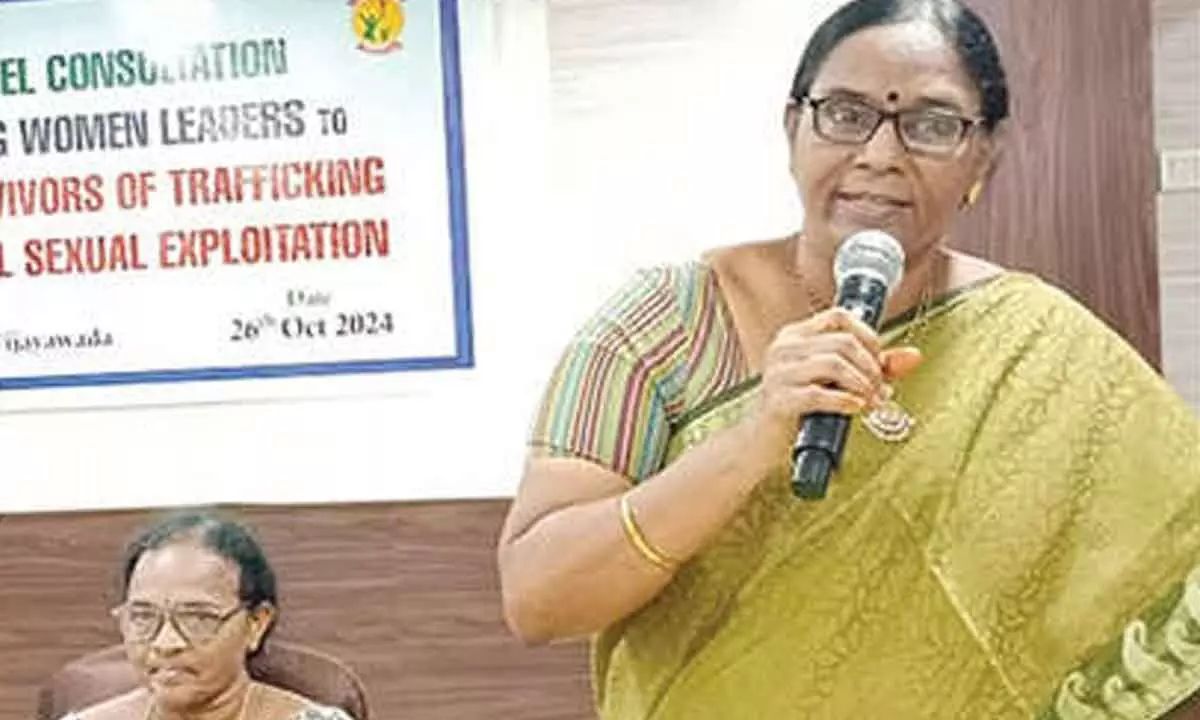Women leaders vow to back victims of sexual exploitation – The Hans India

Women leaders vow to back victims of sexual exploitation
Highlights
Women representatives of various political parties and NGOs have unanimously resolved to extend their collective support to VIMUKTHI survivors for their community-based rehabilitation, victim compensation, and other support services including addressing their issues and challenges through building pressure on the government.

P Durga Bhavani, general secretary of AP Mahila Samakhya, addressing a meeting in Vijayawada on Saturday
Vijayawada: Women representatives of various political parties and NGOs have unanimously resolved to extend their collective support to VIMUKTHI survivors for their community-based rehabilitation, victim compensation, and other support services including addressing their issues and challenges through building pressure on the government.
NGOs, HELP and VIMUKTHI have jointly organized a State-level consultation on Saturday at a hotel with women wing leaders of various political parties and representatives of various people’s organizations on issues and challenges of rescued survivors of trafficking and victims of commercial sexual exploitation.
At the meeting, 60 representatives from POW, AIDWA, NFIW, AP Mahila Samakhya, Dalit Sthree Sakti, women wings of Jana Sena, Bhumika Women Collective, women wing leaders of different political parties, people’s organizations, and various voluntary organizations participated.
The speakers at the meeting said that after State bifurcation, the entire focus of the government has been laid upon the development of the State, improving infrastructure, creating employment, industrialization, and so on. They lamented the successive governments not caring to resolve the issues and challenges of the women from vulnerable backgrounds mainly protection, rehabilitation, and compensation of rescued survivors of human trafficking and victims of commercial sexual exploitation.
Devaki – Janasena party leader, P. Padma, State secretary of POW, Sridevi, secretary of AIDWA, P Durga Bhavani, general secretary of AP Mahila Samakhya, M Hemalatha, leader of Dalith Sthree Sakthi, R Suez, Director, Marpu Trust, Apporva, president of VIMUKTHI, and Radha Kumari, advocate participated.
SDGs, Targets, and Indicators
-
SDG 5: Gender Equality
- Target 5.2: Eliminate all forms of violence against all women and girls in the public and private spheres, including trafficking and sexual exploitation
- Indicator 5.2.1: Proportion of ever-partnered women and girls subjected to physical, sexual, or psychological violence by a current or former intimate partner in the previous 12 months
-
SDG 8: Decent Work and Economic Growth
- Target 8.7: Take immediate and effective measures to eradicate forced labor, end modern slavery and human trafficking, and secure the prohibition and elimination of the worst forms of child labor, including recruitment and use of child soldiers, and by 2025 end child labor in all its forms
- Indicator 8.7.1: Proportion and number of children aged 5-17 years engaged in child labor, by sex and age group
Analysis
The article discusses the collective support of women leaders to victims of sexual exploitation and their commitment to addressing their issues and challenges. Based on the content of the article, the following SDGs, targets, and indicators can be identified:
1. SDG 5: Gender Equality
The article highlights the need to support victims of sexual exploitation, which aligns with SDG 5’s goal of achieving gender equality. Specifically, the article addresses Target 5.2, which aims to eliminate all forms of violence against women and girls, including trafficking and sexual exploitation.
The article implies Indicator 5.2.1, which measures the proportion of ever-partnered women and girls subjected to physical, sexual, or psychological violence by a current or former intimate partner in the previous 12 months. Although the article does not provide specific data on this indicator, it emphasizes the importance of addressing the issues faced by victims of sexual exploitation.
2. SDG 8: Decent Work and Economic Growth
The article mentions the need to address the issues and challenges faced by women from vulnerable backgrounds, including protection, rehabilitation, and compensation for survivors of human trafficking and victims of commercial sexual exploitation. This aligns with SDG 8’s goal of promoting decent work and economic growth.
The article refers to Target 8.7, which aims to eradicate forced labor, end modern slavery and human trafficking, and eliminate child labor. While the article does not provide specific data on this target, it emphasizes the importance of addressing the issues faced by survivors of human trafficking and victims of commercial sexual exploitation.
The article implies Indicator 8.7.1, which measures the proportion and number of children aged 5-17 years engaged in child labor, by sex and age group. Although the article does not focus specifically on child labor, it highlights the need to support survivors of human trafficking, which often involves child exploitation.
Table: SDGs, Targets, and Indicators
| SDGs | Targets | Indicators |
|---|---|---|
| SDG 5: Gender Equality | Target 5.2: Eliminate all forms of violence against all women and girls in the public and private spheres, including trafficking and sexual exploitation | Indicator 5.2.1: Proportion of ever-partnered women and girls subjected to physical, sexual, or psychological violence by a current or former intimate partner in the previous 12 months |
| SDG 8: Decent Work and Economic Growth | Target 8.7: Take immediate and effective measures to eradicate forced labor, end modern slavery and human trafficking, and secure the prohibition and elimination of the worst forms of child labor, including recruitment and use of child soldiers, and by 2025 end child labor in all its forms | Indicator 8.7.1: Proportion and number of children aged 5-17 years engaged in child labor, by sex and age group |
Source: thehansindia.com








